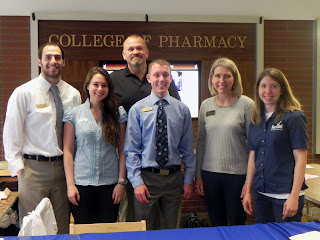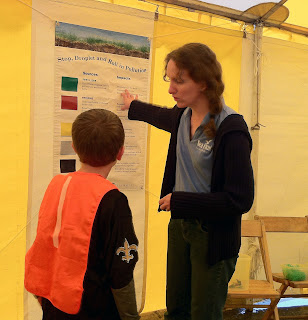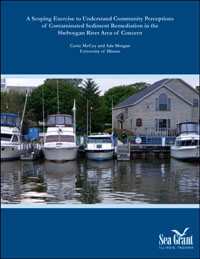Category:
Safe medicine disposal and more highlights from Purdue University’s SpringFest
April 20th, 2012 by Irene MilesIn the news: Wind power from beyond the waves
April 19th, 2012 by Irene MilesThe Great Lakes provide a great many things for millions of people, and there could be a new item added to that impressive list – Wind Power.
Grand Valley State University in Allendale, Michigan is preparing to place a floating research buoy in Lake Michigan to help gather the data needed to determine whether an offshore wind farm in the lake could be feasible and effective.
From NPR:
“Arn Boezaart heads the Michigan Alternative and Renewable Energy Center. Last year the center operated the buoy only 4 miles offshore. This year it’ll collect first of its kind data that’ll likely determine whether an offshore wind farm is viable in the middle of Lake Michigan.
Boezaart says there was a lot more interest in offshore wind data when the project began two-and-a-half years ago.”
Head over to the NPR Blog for the complete article.
Indiana officials working to save some Great Lakes history
April 16th, 2012 by Irene MilesThe Great Lakes, and Lake Michigan specifically, are valuable in a wide range ways. In addition to the unique habitats they provide to numerous species, and the drinking water that millions of people draw from them, the Great Lakes have been valuable and vital paths for transportation and travel. A great deal of cultural and historical information and artifacts lie just beneath the surface of the Lakes, and Indiana is working to save some of that heritage.
From the Northwest Indiana Times:
“Indiana’s movement to preserve its underwater history began in the 1980s when salvagers attempted to raise the wreck of the J.D. Marshall, which sank in 1911 off the shore of the Dunes State Park. Federal and state laws followed in the 1980s, protecting the shipwrecks from salvage operations by imposing fines and imprisonment for looting and vandalism.”
You can read the complete article here.
GLRRIN Lake Michigan partners examine future of Lake Michigan food webs
April 11th, 2012 by Irene MilesThe term “food web” is used to describe the intricate relationships between the many different plants, animals, and organisms that can exist in small or large areas. Understanding food webs in specific environmental locations, such as in one or more of the Great Lakes, can help researchers and communities better respond to changes in those delicate systems. Invasive species are just one example of a potential influence that can drastically alter a food web and have substantial impacts on native environments.
IISG reaches hundreds at National Science Teacher Association Conference
April 10th, 2012 by Irene MilesIISG Associate Director for Education Robin Goettel, Education Specialist Terri Hallesy, AIS Specialist Sarah Zack, and AIS Assistant Danielle Hilbrich attended the National Science Teacher Association’s 2012 Conference March 29-31, and got a tremendous response to the educational resources, tips, and information they offered to the many teachers in attendance.
Visitors learned about how the “Nab the Aquatic Invader” website can be used as an excellent learning tool for grades 4-10, and how the GLRI “Stop Aquatic Hitchhikers” education and outreach initiative informs people what they can do to prevent the spread of aquatic “hitchhikers.” They also distributed brochures on Great Lakes Literacy principles, and CD-ROM copies of the COSEE/Sea Grant “Fresh and Salt” curriculum on important Great Lakes and marine issues.
The “Don’t Let It Loose” poster contains helpful information for teachers about properly disposing of unwanted classroom organisms. Smaller “tip-card” versions of the poster were available too, as well as an adoption pledge containing care tips for students and their families to use when adopting a classroom organism. Some of the highlights at the IISG table were the specimens available for teachers to look at, including a zebra mussel-encrusted shoe, which was a great catalyst to engage teachers in conservation about invasive species.
Study examines community perceptions of river remediation
April 9th, 2012 by Irene MilesCommunication is a crucial part of any project, and especially one as significant as cleaning up an ecosystem that has been deemed an Area of Concern. One of those AOCs is the Sheboygan River, and Illinois-Indiana Sea Grant Environmental Social Scientist Caitie McCoy has been very involved in the remediation project, working with and reaching out to the communities that live near and rely on the river in a variety of ways.
To better understand community views and concerns about the river and the river cleanups going on this summer, several interviews were conducted with local stakeholders. The findings and resulting recommendations are presented in a qualitative study put together by Caitie and Ada Morgan, entitled “A Scoping Exercise to Understand Community Perceptions of Contaminated Sediment Remediation in the Sheboygan River Area of Concern.” You can download and read the entire study here.
Environmentally friendly boating keeps waterways blue and beautiful
April 4th, 2012 by Irene MilesOur friends at New Jersey Sea Grant have some great tips about safe, clean, environmentally friendly things that every boater can do to help the environment while preparing their watercraft for the season. And while there are some differences in conditions between the east coast and our Midwestern lakes and rivers, there are a number of steps that are universally good for protecting the outdoors.
New website provides guidance on properly disposing of unwanted medicines
April 2nd, 2012 by Irene Miles
In the news: Effective and affordable methods could help keep mercury out of Lake Michigan
March 23rd, 2012 by Irene MilesMercury content in water is a health hazard for people, animals, and delicate ecosystems, and preventing its release into the water supply is a major concern. A four-year study has found that there are effective and affordable methods currently available to reduce mercury levels in waste water released at a BP refinery near Lake Michigan.
From the Northwest Indiana Times:
“Scientists from Purdue University Calumet and Argonne National Laboratories who examined the issue for more than four years released their findings in a community briefing at the Hammond campus Tuesday morning.
In 2007, BP funded a $5 million grant to the Purdue University Water Institute and Argonne National Laboratories to research technologies that would help the company meet the 1.3 parts per trillion Clean Water Act standard for mercury.”
Read the complete article here.
Recent News
- Coastal communities can tap into IISG resources as they manage beach sand and structures
- It’s time to apply for the 2026 IISG Graduate Scholars Program
- IISG’s Eliana Brown wins 2025 Illinois Extension Excellence Award
- We’re hiring eight interns for summer 2026
- In 2026, IISG intends to fund 10 research projects focused on coastal concerns
IISG Instagram
Join us next month at the Friends of the Chicago River’s Friends of the Chicago River’s annual Student Congress. We’re excited to attend this free, student-driven environmental conference where we will be leading the Great Plankton Race.
Learn about river issues, connect with peers and professionals, enjoy snacks & giveaways, and even see live animals.
Who: Open to all students, families welcome too!
Where: On the campus of Northeastern Illinois University
When: Saturday, February 28, 2026
8:30 a.m. to 1:30 p.m.
Learn more and register at the link in bio.
#TeachingTuesday #ChicagoRiver

✨ Start Your New Year with Great Lakes Learning! ✨
Kick off 2026 by exploring the Center for Great Lakes Literacy Resource Library. It’s your one-stop hub for lesson plans, activities, and tools to bring Great Lakes science into your teaching setting.
Visit the link in bio to dive in today!
#TeachingTuesday
#GreatLakes #NewYearNewResources

Join us for a hands-on Project WET Make-and-Take Workshop in Chicago!
📅 When: March 12, 2026 from 9:00 AM – 3:30 PM CT
📍 Where: 200 S Wacker Dr., Chicago, IL
💲 Cost: $25 (includes classroom-ready activity kits, lunch & refreshments)
🗓️ Registration closes February 26.
✅ Open to 3rd–8th grade formal & informal educators
✅ Earn 6 PD hours
✅ Leave with ready-to-use water education kits aligned to Common Core & NGSS
👉 Don’t miss out—space is limited!
Learn more and register at the link in bio.
@thengrrec

From supporting cutting-edge research to empowering educators, students, and Great Lakes communities, 2025 was a year of collaboration, learning, and impact.
Thank you to our partners, researchers, educators, and community members who made it all possible. Here’s to another year of protecting, exploring, and sustaining the Great Lakes!

Categories
- Aquaculture
- Aquatic Invasive Species
- Buoys
- Climate Ready Communities
- Coastal Resilience
- Director's Blog
- Education
- Featured
- Fellowships
- Fisheries
- Funded Research
- Funding
- Great Lakes Cleanup
- Great Lakes Data
- Healthy Waters
- Internships
- Jobs
- K-12 Education
- News
- Photos
- Program
- Recreation & Tourism
- Resources
- Sea Grant Scholars
- Stormwater & Green Infrastructure
- Sustainable Community Planning
- The Helm
- Uncategorized
- Video
- Water Resource Economics






